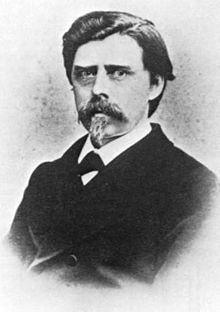David Edward Hughes

David Edward Hughes (born May 16, 1831 in London or Corwen , Wales , † January 22, 1900 in London) was a British-American designer and inventor.
Live and act
David Edward Hughes was the son of David Hughes. In 1838 his parents emigrated with him to Virginia , USA . After finishing school he studied music and science. In 1850 he got a job in Kentucky as a teacher of music, physics and mechanics. In addition to this activity, he conducted extensive technical studies. As a result, Hughes introduced an electric printing telegraph to the public in 1855, the type printing telegraph . In contrast to the Morse code telegraph , directly readable plain text was printed on strips of paper at the sender and receiver.
In 1857 Hughes returned to Great Britain and went to England.
In 1865 he experimented with an imported telephone made by the German physicist and inventor Philipp Reis . Its telephone is considered to be the first functioning device for the transmission of sounds over electrical lines. Hughes was also able to achieve good results with the apparatus.
The ingenuity of the construction is evident from the fact that the "Hughes telegraph" was used worldwide well into the 20th century. Further physical studies led him to introduce an improved carbon microphone to the public in 1878 . It was about the successful continuation of experiments by Thomas Alva Edison and Emil Berliner , which he also substantiated largely theoretically. A description of Hughes' construction can be found here: Hughes Telephone . Apparently his first carbon microphone was so sensitive that the running of a fly could be made audible. Hughes waived a patent and made his microphone freely available.
In 1879 he discovered during experiments with his carbon microphone that the sparks of his equipment caused by a loose contact could be heard in the headphones of a receiver several meters away. He was the first to be able to demonstrate an electromagnetic transmission experimentally, even if he could not scientifically explain the effect at the time and the experts at the time only classified the whole thing as electromagnetic induction .
In further experiments, Hughes generated electrical sparks in a controlled manner using a clockwork breaker.
With this pop-spark transmitter and a portable receiver, he went to Great Portland Street in front of his apartment and was able to receive signals from a distance of approx. 460 m.
On February 20, 1880, he presented his experiments to selected members of the Royal Society . For member George Gabriel Stokes , the observed effect was just a simple electromagnetic induction , not “energy transfer through the air”. Disappointed, Hughes continued the experiments privately and decided not to publish any of his results. He made up for this in an article in the technology magazine The Electrician in 1899 , where he described the experiments he carried out between 1879 and 1886.
David Edward Hughes died at 40 Langham Street in London on January 22, 1900 at the age of 68 . He was buried in Highgate Cemetery , London.
Honors
In 1880 Hughes was elected as a member (" Fellow ") in the Royal Society , which in 1885 awarded him the Royal Medal .
Individual evidence
- ^ "88. David Edward Hughes" ( Memento of May 14, 2009 in the Internet Archive ). 100 Welsh Heroes . Culturenet Cymru.
- ↑ Werner Rammert: Technology from a sociological perspective , Westdeutscher Verlag, Opladen, 1993, ISBN 3-531-12421-8 , p. 249
- ↑ ECS: Calendar of Scientific Pioneers , Nature 106, January 13, 1921, pp. 650f.
- ^ TK Sarkar, Robert Mailloux, Arthur A. Oliner: History of Wireless . John Wiley and Sons, USA 2006, ISBN 0471783013 , pp. 260-261.
- ^ RM Garratt, The Early History of Radio: From Faraday to Marconi, IET - 1994, p. 28
- ^ Thomas Piper: Prof. DE Hughes' Researches in Wireless Telegraphy. In: "The Electrician". May 5, 1899. London 1899, pp. 40-41.
literature
- Hughes, Ivor & Evans, David Ellis: Before we went wireless. David Edward Hughes FRS, his life, inventions and discoveries. Bennington (Images from the Past) 2011, ISBN 978-1-884592-54-6
Web links
- Entry to Hughes; David Edward (1831-1900) in the Archives of the Royal Society , London
| personal data | |
|---|---|
| SURNAME | Hughes, David Edward |
| BRIEF DESCRIPTION | British-American designer and inventor |
| DATE OF BIRTH | May 16, 1831 |
| PLACE OF BIRTH | London |
| DATE OF DEATH | January 22, 1900 |
| Place of death | London |

